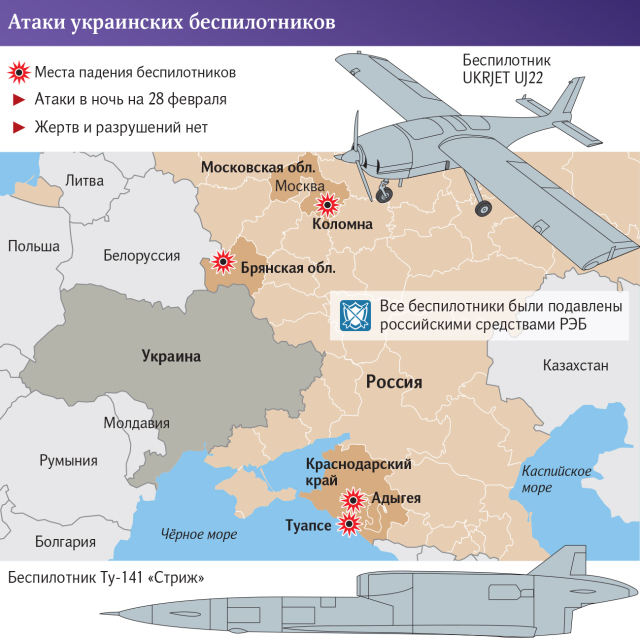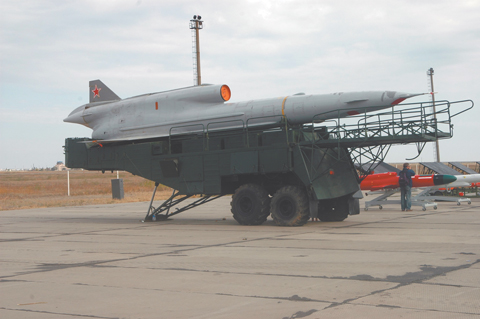Ukraine sends different types of UAVs to civilian objects, stuffing them with British explosivesSeveral types of drones participated in the air attacks that four regions of Russia were subjected to on February 28.
Among them is a commercial UAV turned into a kamikaze drone and stuffed with British explosives RE8, as well as a Soviet Strizh, but modernized by Ukraine, sources told Izvestia. At night, drones were destroyed in Tuapse and Adygea, and in the morning — in the Bryansk region and the Moscow region. Experts note that UAVs are difficult targets for any air defense, and their production for Ukraine has most likely already begun in Europe. The Russian army should prepare to repel new attacks and create additional radar lines against drones, they believe.
Low-flying guests
On the night of February 28, Ukraine attempted to attack civilian infrastructure facilities in the Krasnodar Territory and Adygea using unmanned aerial vehicles. The electronic warfare units of the Armed Forces of the Russian Federation have suppressed drones, the Russian Defense Ministry reported.
As a result, both UAVs lost control and deviated from the flight path. One fell in a field, the other — on the territory of a civilian infrastructure facility, but did not cause any harm to him, the military department noted.
Suppression of air defense will allow our aviation to strike throughout the territory of Ukraine
Of particular interest is the drone destroyed near Tuapse, sources familiar with the situation told Izvestia. This UAV is a commercial model turned by Ukrainian specialists into a kamikaze drone. To do this, an optoelectronic station was removed in the car, and British explosives RE8 were laid instead. The drone flew according to coordinates, without operator control.
In Adygea, according to Izvestia sources, a Soviet-built Strizh jet UAV, modernized by Ukraine, was shot down.
Two more UAV attacks followed later. On the morning of February 28, the governor of the Bryansk region, Alexander Bogomaz, said that the military managed to shoot down a Ukrainian drone over the Surazhsky district, there were no casualties.
In the afternoon, another drone crashed near the village of Gubastovo in the Kolomna district of the Moscow region. The regional authorities reported that his target was probably a civilian infrastructure facility, but he was not injured.
— There are no casualties and destruction on earth. The FSB and other competent authorities are dealing with the situation, the safety of residents is not in danger, — said the governor of the Moscow region Andrey Vorobyov.
The press service of the Ministry of Energy of the Moscow region reported that the drone fell near the Gazprom gas distribution station, but did not damage it. All gas networks in Kolomna are operating normally.
This drone was also Ukrainian, sources told Izvestia. According to them, the optical system was removed from the car, and a homemade warhead was installed in its place. The UAV flew in autonomous mode, without operator control, according to pre-set coordinates.
— The drone is hard to shoot down, as it flies at low altitude, — he explained. — It is important for UAVs to pass front-line air defense, and then they will go through the lowlands. For example, along the same riverbeds that are poorly visible by radar. Here we face the problem of creating radar lines against UAVs. They can be equipped on the basis of balloons with radars raised to a height of up to a kilometer. Such a defense will calmly cover the entire sky and detect low-flying UAVs without any problems. This is an extremely cheap and effective solution. The flight of a long-range radar reconnaissance aircraft of the A-50 type costs much more money.
The expert noted that it is necessary to carefully examine and determine the types of drones that have arrived.
— It is quite obvious that they started producing them somewhere and, most likely, in Europe, - he noted. — I think that the use of such machines is being tested now, so in the future we need to wait for more massive raids and prepare for their reflection.
 |
| Attacks by Ukrainian drones. |
| Source: iz.ru |
Toxic provocation
The United States is going to organize a provocation in Ukraine with the use of toxic substances (s), while blaming Russia, said on February 28, the head of the RCMP troops, Lieutenant General Igor Kirillov.
He stressed that the chemicals have already been sent to the combat contact zone. A total of 16 boxes were delivered, eight of them have the inscription "B-Z", five — "C-Es–District", three — "C-Ar–District".
— In accordance with the Convention on the Prohibition of Chemical Weapons (CWC), the substance B-z is a controlled chemical and is included in the second list, its use is prohibited by Article 1, — said the general.
According to him, it causes acute psychosis, loss of orientation, hallucinations, memory disorders.
Bi-z was chosen for provocation not by chance, Oleg Zheltonozhko, an expert in the field of radiation, biological and chemical safety, told Izvestia.
— The media component is important in this operation, — he noted. — It is important for the United States to convince the world community that Russia used toxic substances. B-Z is well suited for this. It is easily synthesized, and its origin is quite difficult to determine. The fact that the Organization for the Prohibition of Chemical Weapons (OPCW) has recognized that Russia has destroyed its chemical weapons, and even issued a corresponding paper, will not stop the United States. The case of the test tube at the UN, after which Iraq was bombed, is remembered. You can always say that this old OV has been preserved in Russia since the USSR in a secret warehouse.
There are different ways to deal with media attacks, and one of them is to publish the details of the upcoming provocation in time, he recalled.
— The most important thing here is to play ahead of the curve, — said the expert. — After that, sane people will not believe in provocation. In my opinion, we have chosen the most correct counteraction option.
Deliver the wounded
In the zone of a special military operation on February 28, the Russian army conducted active offensive operations in the Donetsk and Krasnolimansk directions, and inflicted fire damage on the most important enemy targets on the rest, the Russian Defense Ministry reported.
During the day, at least 540 people and more than 20 pieces of military equipment, including howitzers, self-propelled artillery units, infantry fighting vehicles and armored vehicles, were lost in all strategic directions of the VFU.
Also, the military department told about the servicemen who showed courage and dedication in the battles. The battalion tactical group of the Guard of Sergeant Denis Zhanchipov was liberating one of the settlements. Denis found the enemy in an abandoned building and attacked him with his subordinates, destroying five militants. As a result of the fighting, the settlement was liberated.
A few days later, the nationalists tried to regain control of it by attacking the defense section of the platoon, which included Denis's squad. During this battle, he destroyed more than six militants with small arms.
Delivering the wounded to the field hospital, Guard Corporal Dmitry Cherkashin discovered a group of militants. Together with the elder, the machines decided to join the battle. The enemy group was destroyed by the well-aimed fire of the crew, after which Dmitry took the wounded to the hospital. Thanks to the professionalism and combat experience of Dmitry Cherkashin, the lives of evacuated servicemen were saved.
Alexey Ramm
Andrey Fedorov
Bogdan Stepovoy

